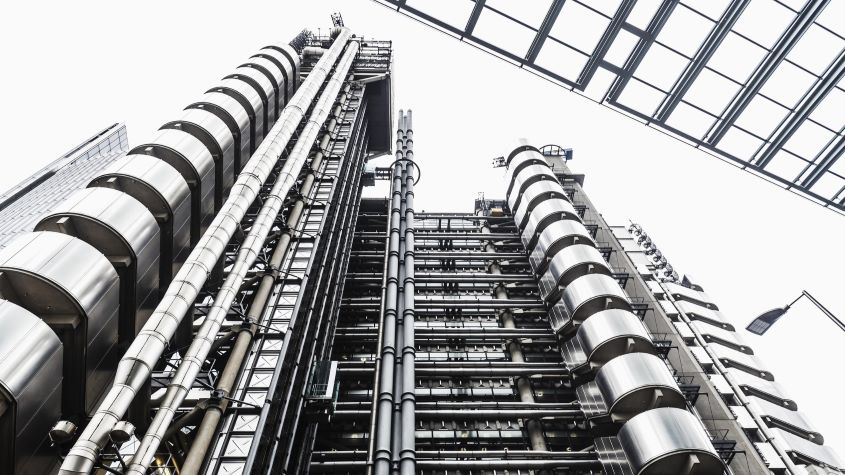Lloyd’s of London: Invest in the DNA of global capitalism
Commercial insurance makes the world go round – and Lloyd’s of London sits at the core of the global market, which is embarking on an upswing, says Rupert Hargreaves. Investors should hop aboard now.


The City of London is one of the world’s most important financial centres, especially when it comes to insurance. I’m not talking about the general insurance market (covering cars or health, for instance), but the global one for large business-insurance policies and reinsurance. This type of insurance is the oil that keeps the wheels of the global economic machine moving. Without it, trust would dissolve and the economy would be far more volatile.
The Global Cities Report of 2021 notes that London is the only city in the world where every top-20 insurance and reinsurance firm has a base. The insurance sector comprised 24% of the City’s GDP in 2020, according to the London Market Group, which represents insurers and reinsurers. And at the heart of this network is the Lloyd’s of London insurance market.
The oil in the world economy’s motor
All insurance policies are, in the most basic sense, a transfer of risk. For a fixed fee, or premium, I can buy an insurance policy, which will pay out when a certain event occurs. The insurer will try to price the premium correctly based on the assessment of the potential losses and probability of the event playing out. In theory, if the insurance company has done its sums right, the total amount received from customers in premiums every year will be more than it pays out in losses.
MoneyWeek
Subscribe to MoneyWeek today and get your first six magazine issues absolutely FREE

Sign up to Money Morning
Don't miss the latest investment and personal finances news, market analysis, plus money-saving tips with our free twice-daily newsletter
Don't miss the latest investment and personal finances news, market analysis, plus money-saving tips with our free twice-daily newsletter
A key figure in the industry is the combined ratio. This is the ratio of total underwriting losses, in adition to the costs of running the business, compared with the total amount of premium income received. A combined ratio of more than 100% means the company is paying out more in losses and expenses that it is receiving in premium income, while a ratio below 100% means premium income exceeds these costs. Every insurance company aims to have a ratio of below 100%.
Reinsurance spreads insurance risk further. For example, if a company is selling home insurance in Florida, there’s a high risk it will suffer high losses in its portfolio if there’s a huge hurricane. No matter how accurate a company’s sums are in this case, the sheer scale of the losses could bankrupt it. So, to reduce the risk, it’ll reinsure its portfolio, paying other insurers to take on some of the risk. Reinsurers can then purchase their own reinsurance, a process called retrocession, to spread risk even further.
The global insurance and reinsurance markets work the same way, although the numbers are much, much bigger. This risk transfer is the oil that helps the engine of the global economy work more efficiently. Traders and firms know how much risk they’re exposed to, and if insurers pay out quickly, these customers can carry on business without too much interruption. That’s why it has been said that insurance is the DNA of capitalism.
It could be argued that not having insurance is a bigger risk than anything else, something BP knows all too well. It had opted to self-insure its operations in the Gulf of Mexico to save money, but in 2010 when the oil rig Deepwater Horizon failed, it was on the hook for all of the resulting losses. Today, BP has paid out $70bn in compensation and clean-up costs, selling valuable assets to foot the bill. If it had chosen to buy insurance, the $70bn bill would have been absorbed by several firms across the insurance industry.
Insuring oil rigs and satellites
As the global insurance marketplace has expanded over the past 300 years, Lloyd’s has carved out a niche for itself. This is not a place you go to buy an insurance policy on your iPhone . Its network of capital providers, brokers (who speak to the underwriters on behalf of clients) and underwriters help clients insure specialist risks: it’s a marketplace, not a single entity.
These specialist risks can be anything from oil rigs to satellites. It also insures against cybersecurity attacks, cargo ships sinking and works of art being stolen or damaged. It has a reputation for insuring things others won’t. For example, the first cars were insured through the Lloyd’s market; they were described as a “ship navigating on land.” The market has also become well known as a place where actors and models can insure various body parts, and in one case, Members of the Derbyshire Whiskers Club insured their beards against fire and theft. Lloyd’s is also is the world’s seventh-largest reinsurer. Private investors and wealthy individuals were the first capital providers to the market, although today their share of the market is just 8.3%. But investing in the Lloyd’s insurance market as an individual remains an attractive proposition.
Two options for investors
There are two ways investors can buy exposure to the Lloyd’s market. They can acquire shares in a corporation that has a foothold in the market, such as Hiscox (LSE: HSX), Beazley (LSE: BEZ) or Lancashire Holdings (LSE: LRE). Or they can invest directly as a capital provider.
All three listed firms have a foothold in the Lloyd’s market but also operate independent businesses. Hiscox is a leading provider of small-business insurance and is making inroads into the high-value home-insurance market. Beazley is rapidly becoming one of the world’s leading cybersecurity providers (both in the Lloyd’s market and independently), and Lancashire has been working on its reinsurance offering as well as advising third parties with its Lancashire Capital Management arm. All three are applying lessons learned by working in the Lloyd’s market to drive their expansion.
A good benchmark to use for valuing insurers is book value, with a price of more than twice book being too high. On that basis, Lancashire is the cheapest. It’s trading at a price-to-book value ratio (p/b) of 1.4. Beazley is on 1.8 and Hiscox 2.1.
The primary capital providers to the market until the mid -1990s were individuals known as names. Names entered the market in an unlimited capacity: all of their assets could be at risk if the losses from the market were big enough. After a series of scandals in the early 1990s that wiped out many names, and threatened the future of the market, Lloyd’s was forced to change.
After the crisis, the market introduced new rules and regulations to improve underwriting standards, the quality of capital and protection for investors. The market now has strict capital rules for all participants and requires in-depth risk models to gauge insured risks and highlight areas of weakness. Today, new private investors cannot join as unlimited names. They must join through a Limited Liability Vehicle (LLV), such as a Limited Liability Partnership or a Limited Company. LLVs have significant tax advantages. Both are inheritance tax (IHT)-free as businesses qualifying for Business Property Relief after two years.
In theory, anyone can invest directly into the market, although Lloyd’s used to recommend a minimum of £350,000 and investors are advised to deploy no more than 10% of their assets. Members’ Agents act as the bespoke wealth managers for investors in the market. The largest is Hampden Agencies, which looks after more than half of the private capital in the market today. Alpha Insurance and Argenta Private Capital are two other big names.
Investors have to work with a Members’ Agent to invest in the Lloyd’s market as these agents will ensure investors have adequate capital, produce research on the market and carry out due diligence work such as money laundering checks. An investor also has to select a portfolio of syndicates – these operate like little insurance companies – which they want to back in the market when they join (and can change yearly if they wish); their Members’ Agent will advise on this. Each syndicate operates in a different area of the insurance market specialising in various classes of business and areas of the world, so each has its own risk profile and team of underwriters.
This is a key point: there is a wide dispersion in underwriting performance for all syndicates. That’s just as true with Lloyd’s syndicates as it is with public-market insurance equities. As the famous investor Shelby Davis once noted, “it’s not the winners I’ve owned, it’s the losers I’ve not [owned]”
Hampden is the only Members’ Agent to construct discretionary portfolios, known as MAPAs, for its clients – one of the most straightforward ways to deploy capital into the market. Its experienced analysts pick a selection of syndicates to back with the goal of building a diversified portfolio. These structures are very similar to Open Ended Investment Companies (OEICs) on equity markets. Investors make a commitment to how much they wish to invest, and the Hampden MAPA Manager goes out to deploy that capital. This enables investors to take a more passive approach.
Every insurance company has a portfolio of securities to back up its underwriting activity, and the same applies to private capital vehicles at Lloyd’s. Insurance can be a risky business and every policyholder stakeholder needs to know underwriters can meet their commitments when they fall due. Investors must therefore provide collateral to back up their underwriting and syndicate exposure; this is known as Funds at Lloyd’s (FAL): the equivalent of shareholders’ funds for an insurance company.
The amount of collateral required is based on total exposure through syndicates, and this pot will be used to pay losses if and when they arrive. Every insurer has to have these reserves. Warren Buffett has called this capital the “float,” and he’s become a master of leveraging the capital to the maximum.
The float (both within Lloyd’s and across the rest of the industry) can be invested in the equity or bond markets as long as the company does not breach regulatory capital requirements. Investors in the Lloyd’s market can also use a bank guarantee or letter of credit secured against assets they hold outside of Lloyd’s.
This dual use of assets is one of the reasons investing in Lloyd’s can be so appealing: investors can earn profits from underwriting while the “float” can earn money in the equity market.
Over the 20 years to 2021, Hampden’s discretionary private client MAPAs have returned on average 24.7% on capital from underwriting before fees, expenses and tax. The MSCI World Index (measured in sterling) has returned an annual 9.38% in the same period. So when combined, the dual use of assets could have provided investors with a 34% gross return on capital over the two-decade period before fees, expenses and taxes.
With these sorts of returns, no wonder Warren Buffett became one of the richest people in the world by leveraging an insurance business and investment portfolio at Berkshire Hathaway. And there’s scope for investors to do the same with a Lloyd’s vehicle.
The Lloyd’s market has turned a corner
Despite the insurance market’s strengths, Lloyd’s and the rest of the sector have struggled in recent years. Following a period of low losses on catastrophes in the early 2010s, rates charged by underwriters fell as companies competed for business. Then a series of disasters occurred in 2017, inflicting huge losses, and the trend has continued. According to the Swiss Re Institute, since 2017 insurers and reinsurers have paid out $650 billion (in 2022 prices) for weather-related natural catastrophes claims. Annual losses of $25bn used to be the norm. Now, it’s $100bn. To begin with, reinsurers had to take these losses on the chin. Financial data provider S&P Global recorded an overall combined ratio for the sector of 103.7% in 2017.
However, the market has adjusted. Since 2018 property reinsurance rates in the US have jumped by nearly 100%, according to the Guy Carpenter Rate-On-Line Index. Meanwhile, rates charged by Lloyd’s underwriters have increased by 44.5% since 2018 across all classes of business. The pricing of these types of catastrophe-exposed property insurance can adjust quickly to changes in the loss environment as they are renewed annually.
According to John Francis, the Head of Research at Lloyd’s Members’ Agent Hampden, and the man responsible for the firm’s MAPA arrangements, successful insurance is “ultimately about pricing.” Insurance premiums must reflect the risk accurately. While it’s taken some time for the sector to adjust, “the [Lloyd’s] market has now adjusted to reflect the increased exposure from climate change.”
Swiss Re notes 2022 was the “third-costliest” year on record for the insurance industry with regard to natural disasters. Losses totalled $132bn overall, compared with a ten-year average of $91bn. The P&C industry as a whole saw its combined ratio spike above 100% again off the back of these losses (estimates put the figure between 102% and 106%), but Lloyd’s focus on its core markets is paying off.
It’s “all about managing exposure,” Francis says. Despite the global losses last year, Lloyd’s generated a combined ratio of 91.9% and a portfolio of high-quality syndicates selected by Hampden is forecast to generate a return on capital of 15.4%. This profit
shows that “a diversified portfolio of insurance risks was able to absorb catastrophe losses and still make a profit in 2022.”
Not only is this return attractive compared with the rest of the industry, but it also beats other asset classes. Asset management giant Vanguard notes that a traditional 60/40 global stock/bond portfolio lost 15.7% last year, the worst annual showing since 1937.
This environment of rising insurance and reinsurance rates, along with tightening terms and conditions (known as a hard market) is expected to endure as losses mount worldwide. The Lloyd’s market is uniquely positioned to take advantage by focusing on its core competencies. Private investors in the Lloyd’s market could earn handsome returns from this uncorrelated, tax-efficient and unique investment.
Get the latest financial news, insights and expert analysis from our award-winning MoneyWeek team, to help you understand what really matters when it comes to your finances.

Rupert is the former deputy digital editor of MoneyWeek. He's an active investor and has always been fascinated by the world of business and investing. His style has been heavily influenced by US investors Warren Buffett and Philip Carret. He is always looking for high-quality growth opportunities trading at a reasonable price, preferring cash generative businesses with strong balance sheets over blue-sky growth stocks.
Rupert has written for many UK and international publications including the Motley Fool, Gurufocus and ValueWalk, aimed at a range of readers; from the first timers to experienced high-net-worth individuals. Rupert has also founded and managed several businesses, including the New York-based hedge fund newsletter, Hidden Value Stocks. He has written over 20 ebooks and appeared as an expert commentator on the BBC World Service.
-
 Football fans issued warning over ticket scams ahead of 2026 World Cup
Football fans issued warning over ticket scams ahead of 2026 World CupSantander customers lost more to football scams in the first six months of 2025 compared to the same period in 2024, when total losses surged due to the Euros
-
 Nationwide fined £44 million over “inadequate” anti-money laundering systems
Nationwide fined £44 million over “inadequate” anti-money laundering systemsFailings in Nationwide’s financial crime processes between October 2016 to July 2021 meant one criminal was able to deposit £26 million from fraudulent Covid furlough payments in just eight days.
-
 Halifax: House price slump continues as prices slide for the sixth consecutive month
Halifax: House price slump continues as prices slide for the sixth consecutive monthUK house prices fell again in September as buyers returned, but the slowdown was not as fast as anticipated, latest Halifax data shows. Where are house prices falling the most?
-
 Rents hit a record high - but is the opportunity for buy-to-let investors still strong?
Rents hit a record high - but is the opportunity for buy-to-let investors still strong?UK rent prices have hit a record high with the average hitting over £1,200 a month says Rightmove. Are there still opportunities in buy-to-let?
-
 Pension savers turn to gold investments
Pension savers turn to gold investmentsInvestors are racing to buy gold to protect their pensions from a stock market correction and high inflation, experts say
-
 Where to find the best returns from student accommodation
Where to find the best returns from student accommodationStudent accommodation can be a lucrative investment if you know where to look.
-
 The world’s best bargain stocks
The world’s best bargain stocksSearching for bargain stocks with Alec Cutler of the Orbis Global Balanced Fund, who tells Andrew Van Sickle which sectors are being overlooked.
-
 Revealed: the cheapest cities to own a home in Britain
Revealed: the cheapest cities to own a home in BritainNew research reveals the cheapest cities to own a home, taking account of mortgage payments, utility bills and council tax
-
 UK recession: How to protect your portfolio
UK recession: How to protect your portfolioAs the UK recession is confirmed, we look at ways to protect your wealth.
-
 Buy-to-let returns fall 59% amid higher mortgage rates
Buy-to-let returns fall 59% amid higher mortgage ratesBuy-to-let returns are slumping as the cost of borrowing spirals.